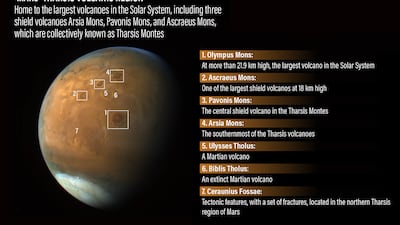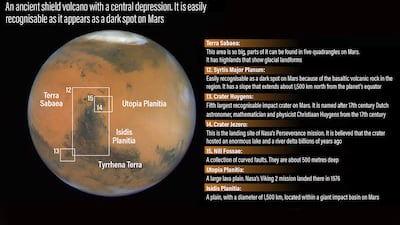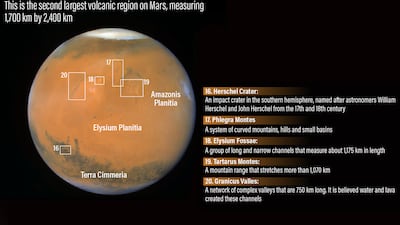A new treasure trove of Mars data containing hundreds of images captured by the UAE's Hope probe is set to give the world a greater understanding of the Red Planet.
The latest release of data sheds new light on some of the planet's key geographical features, such as Olympus Mons, the largest volcano in the solar system, and Valles Marineris, a canyon network that is 4,000-kilometres long and reaches depths of up to 7km.
Images gathered by Hope are also putting Mars's ice caps and clouds into sharper focus.
Enthusiasts believe the information shared by the UAE will help people around the world to engage with the topic of space travel.
A high-resolution camera, called the eXploration imager instrument, aboard the Hope probe is also allowing scientists to create stunning images of the planet.
They are processing the raw monochromatic images to highlight geographical features such as Olympus Mons, ice caps and clouds.
Images processed by the public can help scientists in their research, as it means multiple eyes and hands on the thousands of images a spacecraft sends back.
Pictures bring Mars to life
Stuart Atkinson, who is based in the UK, has been processing some of the images by the Hope probe.
“There are some very striking new views of familiar features in the new data set, like Olympus Mons and Valles Marineris, a canyon system,” he said.
“We never get bored of seeing these, and the Hope probe is sending back wonderful new views of them.
“It's great that this data is being released so freely and quickly - unlike the images taken by the Indian and Chinese missions. It definitely helps people connect with the mission, and see Mars as a real place, a real world, not just a red star in the sky.
“I love the views from the eXploration imager because they let me imagine how I'd see Mars if I was approaching it in a spacecraft as a future explorer.”
Since arriving into Mars's orbit on February 9, 2021, the spacecraft has beamed back images revealing the planet's dynamic weather system and atmospheric conditions.
Earlier this month, the Mohammed bin Rashid Space Centre released 76.5 gigabytes of data captured between May 4 and August 31.
The latest addition brings the total amount of data released to 312 gigabytes. The mission aims to collect one terabyte in its two-year operation.
These observations are helping planetary scientists study how the planet lost its atmosphere and how the weather changes daily and seasonally.
Andrea Luck, based in Scotland, is another space image processor who has been sharing images of the planet captured by the Hope probe.
Some of his images have been widely shared on Twitter, including ones that show the planet’s northern ice cap and clouds in the Arsia Mons caldera – a large volcanic crater.
“The pictures coming from the Hope Probe’s eye, the eXploration imager, are simply incredible and very easy to access for the public,” Mr Luck said.
“If you like to process space photos, you’ll be amazed by the quality of each filter.
“It’s such a milestone to have so many international missions sharing their data with the entire planet - a very strong message for humanity, but also having the possibility to have more probes working at the same time on a target gives us the chance to compare data and verify any discovery.”
The data will also help Dr Dimitra Atri, a planetary scientist at the New York University in Abu Dhabi, who is creating an atlas to show how Mars changes with time, including daily and seasonal variations.
The Hope probe is circling the planet in an elliptical orbit that allows it to observe from much further away than any other spacecraft.
Its strategic position will help researchers such as Dr Atri to create a global image of the planet.
“The idea is to produce an atlas which will be of use both for the global scientific community and the public at large,” Dr Atri said.
“Having followed this mission for a very long time, it gives me great satisfaction to not only study the planet to solve research problems but to share it with the wider community.”
The Mohammed bin Rashid Space Centre has promised to release a new set of data every three months.
Coffee: black death or elixir of life?
It is among the greatest health debates of our time; splashed across newspapers with contradicting headlines - is coffee good for you or not?
Depending on what you read, it is either a cancer-causing, sleep-depriving, stomach ulcer-inducing black death or the secret to long life, cutting the chance of stroke, diabetes and cancer.
The latest research - a study of 8,412 people across the UK who each underwent an MRI heart scan - is intended to put to bed (caffeine allowing) conflicting reports of the pros and cons of consumption.
The study, funded by the British Heart Foundation, contradicted previous findings that it stiffens arteries, putting pressure on the heart and increasing the likelihood of a heart attack or stroke, leading to warnings to cut down.
Numerous studies have recognised the benefits of coffee in cutting oral and esophageal cancer, the risk of a stroke and cirrhosis of the liver.
The benefits are often linked to biologically active compounds including caffeine, flavonoids, lignans, and other polyphenols, which benefit the body. These and othetr coffee compounds regulate genes involved in DNA repair, have anti-inflammatory properties and are associated with lower risk of insulin resistance, which is linked to type-2 diabetes.
But as doctors warn, too much of anything is inadvisable. The British Heart Foundation found the heaviest coffee drinkers in the study were most likely to be men who smoked and drank alcohol regularly.
Excessive amounts of coffee also unsettle the stomach causing or contributing to stomach ulcers. It also stains the teeth over time, hampers absorption of minerals and vitamins like zinc and iron.
It also raises blood pressure, which is largely problematic for people with existing conditions.
So the heaviest drinkers of the black stuff - some in the study had up to 25 cups per day - may want to rein it in.
Rory Reynolds
Ruwais timeline
1971 Abu Dhabi National Oil Company established
1980 Ruwais Housing Complex built, located 10 kilometres away from industrial plants
1982 120,000 bpd capacity Ruwais refinery complex officially inaugurated by the founder of the UAE Sheikh Zayed
1984 Second phase of Ruwais Housing Complex built. Today the 7,000-unit complex houses some 24,000 people.
1985 The refinery is expanded with the commissioning of a 27,000 b/d hydro cracker complex
2009 Plans announced to build $1.2 billion fertilizer plant in Ruwais, producing urea
2010 Adnoc awards $10bn contracts for expansion of Ruwais refinery, to double capacity from 415,000 bpd
2014 Ruwais 261-outlet shopping mall opens
2014 Production starts at newly expanded Ruwais refinery, providing jet fuel and diesel and allowing the UAE to be self-sufficient for petrol supplies
2014 Etihad Rail begins transportation of sulphur from Shah and Habshan to Ruwais for export
2017 Aldar Academies to operate Adnoc’s schools including in Ruwais from September. Eight schools operate in total within the housing complex.
2018 Adnoc announces plans to invest $3.1 billion on upgrading its Ruwais refinery
2018 NMC Healthcare selected to manage operations of Ruwais Hospital
2018 Adnoc announces new downstream strategy at event in Abu Dhabi on May 13
Source: The National
UAE currency: the story behind the money in your pockets
UAE currency: the story behind the money in your pockets
Frankenstein in Baghdad
Ahmed Saadawi
Penguin Press
Joy%20Ride%20
%3Cp%3E%3Cstrong%3EDirector%3A%3C%2Fstrong%3E%20Adele%20Lim%3Cbr%3E%3Cstrong%3EStars%3A%20%3C%2Fstrong%3EAshley%20Park%2C%20Sherry%20Cola%2C%20Stephanie%20Hsu%2C%20Sabrina%20Wu%3Cbr%3E%3Cstrong%3ERating%3A%20%3C%2Fstrong%3E4%2F5%3C%2Fp%3E%0A
ALL THE RESULTS
Bantamweight
Siyovush Gulmomdov (TJK) bt Rey Nacionales (PHI) by decision.
Lightweight
Alexandru Chitoran (ROU) bt Hussein Fakhir Abed (SYR) by submission.
Catch 74kg
Omar Hussein (JOR) bt Tohir Zhuraev (TJK) by decision.
Strawweight (Female)
Seo Ye-dam (KOR) bt Weronika Zygmunt (POL) by decision.
Featherweight
Kaan Ofli (TUR) bt Walid Laidi (ALG) by TKO.
Lightweight
Abdulla Al Bousheiri (KUW) bt Leandro Martins (BRA) by TKO.
Welterweight
Ahmad Labban (LEB) bt Sofiane Benchohra (ALG) by TKO.
Bantamweight
Jaures Dea (CAM) v Nawras Abzakh (JOR) no contest.
Lightweight
Mohammed Yahya (UAE) bt Glen Ranillo (PHI) by TKO round 1.
Lightweight
Alan Omer (GER) bt Aidan Aguilera (AUS) by TKO round 1.
Welterweight
Mounir Lazzez (TUN) bt Sasha Palatkinov (HKG) by TKO round 1.
Featherweight title bout
Romando Dy (PHI) v Lee Do-gyeom (KOR) by KO round 1.
What can victims do?
Always use only regulated platforms
Stop all transactions and communication on suspicion
Save all evidence (screenshots, chat logs, transaction IDs)
Report to local authorities
Warn others to prevent further harm
Courtesy: Crystal Intelligence
Dubai Bling season three
Cast: Loujain Adada, Zeina Khoury, Farhana Bodi, Ebraheem Al Samadi, Mona Kattan, and couples Safa & Fahad Siddiqui and DJ Bliss & Danya Mohammed
Rating: 1/5
More on animal trafficking
More coverage from the Future Forum























